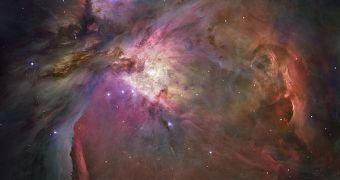All living things on the planet carry within them the basic components of life, which come in the form of 20 types of amino-acids, each of which was absolutely essential in promoting the emergence of the first living things. What has been amazing for researchers for quite some time now is the fact that all of these amino-acids, and, consequently, all living things have a left-hand orientation, or chirality. This holds true for all living things, so experts are even now trying to determine what caused this chirality, and how it influenced early life, Technology Review informs.
According to astrobiologists, which spend time trying to discover life on other planets, or calculating the possibility of life existing in other corners of the Universe, it may be that light coming in from the Orion Nebula carries with it clues to explain the Earth life's left-handedness. They also add that both right- and left-handed molecules are produced in equal amount. So their question is why does life prefer one orientation over the other, and living things do not feature both chiralities in equal amounts? One enantiomer, the basic unit of life for the vast majority of organisms, is made up of a left-handed amino acid and right-handed sugars.
Just today, January 19, Japanese experts led by scientist Tsubasa Fukue, from the National Astronomical Observatory of Japan, in Tokyo, announce that they might have found a possible explanation for this homochirality. They argue that they came to this conclusion after analyzing light coming in from the Orion Nebula, which is an active stellar nursery, and also one of the most beautiful space structures ever discovered by man. “Studies of the Orion star-forming region enable us to investigate processes that may have occurred during the birth of our own solar system,” the group explains. The scientists are basically arguing that Orion must feature many proto-solar systems that look like ours did when it first appeared, some 4.6 billion years ago.
Inside the Nebula, in an area some 400 times larger than the solar system, the research group found circularly polarized visible light permeating everything. Most likely, this type of light was created by the synchrotron radiation that is emitted from particles accelerated inside massive magnetic fields. The team also knows that, on our planet, polarized light can influence certain types of chemical reactions to specific outcomes, such as selecting a specific chirality. Still, on Earth, polarized ultraviolet (UV) light is needed for this, not visible light. The difficulty with this scenario is that it's impossible to view polarized UV light from Orion.
This type of electromagnetic radiation is very efficiently absorbed by the dust clouds that exist between the structure and our solar system. Fukue and his group say that computer models seem to indicate that this specific type of UV light is indeed produced in such areas. He also adds that previous observations determined the existence of amino-acids in space. In other words, he argues that the conditions are set in that specific region of the Orion Nebula for the emergence of homochirality, just as it exists on the Earth.

 14 DAY TRIAL //
14 DAY TRIAL //